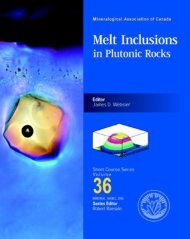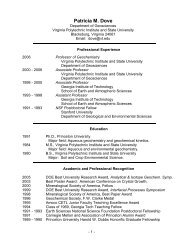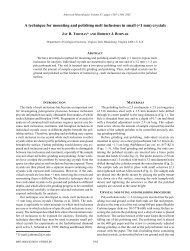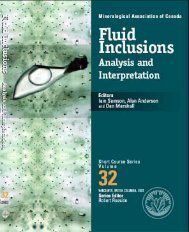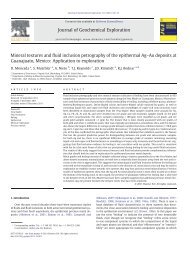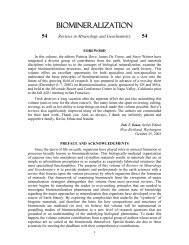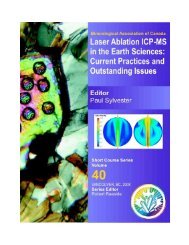Biomineralization Within Vesicles: The Calcite of Coccoliths
Biomineralization Within Vesicles: The Calcite of Coccoliths
Biomineralization Within Vesicles: The Calcite of Coccoliths
You also want an ePaper? Increase the reach of your titles
YUMPU automatically turns print PDFs into web optimized ePapers that Google loves.
194 Young & Henriksencalcification and have been shown to be complexes <strong>of</strong> acidic polysaccharides withcalcium ions (Marsh 1994). It is thought that they function as calcium vectors duringbiomineralization and that the polysaccharide phase forms the crystal coatings.Detailed cytological observations on heterococcolith formation have also been madeon Emiliania huxleyi (e.g., Wilbur and Watabe 1963; Klaveness 1976; van der Wal et al.1983b, van Emburg et al 1986), while for a few other species there are isolated usefulstudies, including notably: Manton and Leedale (1969) − Coccolithus pelagicus; Inouyeand Pienaar (1984) − Umbilicosphaera sibogae; Inouye and Pienaar (1988) −Syracosphaera pulchra. <strong>The</strong>re is significant diversity in these observations, for instancecoccolithosomes are only known in Pleurochrysis, and in E. huxleyi the base-plate scaleis a very nebulous structure. Also in E. huxleyi calcification occurs in the “reticularbody,” an organelle that is separated from the Golgi body, but is thought to be derivedfrom it. Nonetheless, a clear overall pattern is similar in all cases, with calcificationoccurring in Golgi-derived vesicles and commencing with nucleation <strong>of</strong> a proto-coccolithring <strong>of</strong> simple crystals around the rim <strong>of</strong> a precursor base-plate scale, followed by growth<strong>of</strong> these crystals in various directions to form complex crystal units.Biochemical aspects: organic molecules involved in coccolith biomineralization<strong>The</strong> control by organisms on mineral expression is to a large extent attributed to theinfluence <strong>of</strong> organic molecules on nucleation and growth. Organic matrix frameworkscan provide binding sites for the components <strong>of</strong> a mineral, selectively nucleating specificcrystallographic faces, and organic carrier molecules can ensure supersaturation <strong>of</strong> aphase within mineralizing compartments. On a larger scale, shape regulation <strong>of</strong> suchcompartments can direct the morphology <strong>of</strong> biominerals forming within them (Mann1993). In the case <strong>of</strong> coccoliths, the primary organic molecules involved are complexacidic polysaccharides (Fichtinger-Schepman et al. 1981; Marsh et al. 1992; Marsh 1994;Ozaki et al. 2001; Marsh et al. 2002).<strong>The</strong> coccolith-associated polysaccharides (CAPs) <strong>of</strong> two species have been isolatedand analyzed. In Emiliania huxleyi, one polysaccharide has been located, having abackbone <strong>of</strong> mannose with many complex sidechains <strong>of</strong> galacturonic acid as well asester-bound sulphate groups (Fichtinger-Schepman et al. 1981). In the case <strong>of</strong>Pleurochrysis carterae, the situation is more complex, with 3 types <strong>of</strong> polysaccharidepresent (PS1, PS2, PS3; Marsh et al. 2002). PS1 and PS2 bind calcium and formcoccolithosomes, with PS2 probably playing an important role in the nucleation <strong>of</strong> theproto-coccolith ring, as evidenced by mutant P. carterae cells deficient in thispolysaccharide showing very little calcification (Marsh and Dickinson 1997). Duringcoccolith growth, PS3 is located between the crystals and the vesicle, and its function isbelieved to be shape regulatory, because P. carterae cells not expressing PS3 produce aproto-coccolith ring that does not develop further (Marsh et al. 2002). It is likely thatsimilar polysaccharides are active in other species <strong>of</strong> coccolithophore, instrumental inproducing their elaborately complex coccoliths.<strong>The</strong> active role inferred from this work for polysaccharides is unusual, since in mostbiomineralizing systems proteins are the key functional molecules. Proteins are alsoattractive targets for research since they are synthesized by RNA, allowing a range <strong>of</strong>genomic techniques to be applied to protein studies. However, despite extensive research,there has been only limited success to date in isolating and characterizing proteinsassociated with coccolith formation (Corstjens et al. 1998). This apparent anomaly is lesssurprising from an ecological perspective. Coccolithophores are photosynthetic algae,and a prime constraint on algal abundance in most oceanic environments is availability <strong>of</strong>nutrient elements for biosynthesis, especially N and P (e.g., Brand 1994). Sequestration



